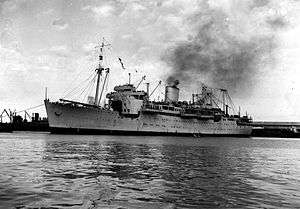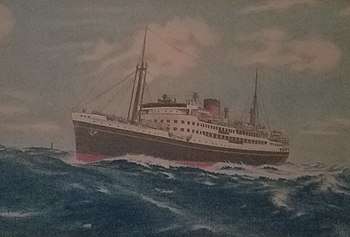HMAS Kanimbla (C78)
HMAS Kanimbla was a passenger ship converted for use as an armed merchant cruiser and landing ship infantry during World War II. Built during the mid-1930s as the passenger liner MV Kanimbla for McIlwraith, McEacharn & Co, the ship operated in Australian waters until 1939, when she was requisitioned for military service, converted into an armed merchant cruiser, and commissioned in the Royal Navy as HMS Kanimbla.
 HMAS Kanimbla at Fremantle Harbour 1945 | |
| History | |
|---|---|
| Namesake: | Kanimbla Valley |
| Builder: | Harland & Wolff, Belfast |
| Laid down: | July 1933 |
| Launched: | 15 December 1935 |
| Commissioned: | 6 September 1939 (Royal Navy) |
| Recommissioned: | 1 June 1943 (Royal Australian Navy) |
| Decommissioned: | 25 March 1949 |
| Renamed: |
|
| Reclassified: |
|
| Honours and awards: |
|
| Fate: | Returned to civilian service |
| General characteristics | |
| Displacement: | 10,985 tons |
| Length: | 468.8 ft (142.9 m) |
| Beam: | 66.3 ft (20.2 m) |
| Draught: | 24.4 ft (7.4 m) |
| Propulsion: | Diesel engines, twin screws. 10,000 horsepower |
| Speed: | 19 knots (35 km/h; 22 mph) |
| Capacity: | 1,380 troops (as landing ship) |
| Complement: | 345 |
| Armament: |
|
Initially used to board and take control of merchant vessels belonging to Occupied Europe and operating in Asian waters, Kanimbla led the raid to capture the Iranian port of Bandar Shahpur in August 1941, and was present during the covert Japanese midget submarine attack on Sydney Harbour in 1942. In 1943, the ship was converted into a Landing Ship Infantry, transferred to the Royal Australian Navy, and operated throughout the South West Pacific Theatre until the end of the war.
Kanimbla was decommissioned and returned to her commercial owners in 1950. In 1961, she was sold to the Pacific Transport Company and renamed Oriental Queen. The ship operated as a liner throughout the Pacific and to Japan until 1973, when she was broken up for scrap.
Construction

The ship was laid down as motor vessel (MV) Kanimbla for McIlwraith, McEacharn & Co by Harland & Wolff, Belfast.[1] She was launched on 15 December 1935 and completed in 1936.[2][3]
The ship was named for the Kanimbla Valley, west of Blackheath in the Blue Mountains in New South Wales.[4]
Operational history
Pre-war

The ship arrived in Melbourne 12 June 1936 and operated a passenger service between Cairns and Fremantle. The ship accommodated 203 first class and 198 cabin class passengers. This passenger service continued until the outbreak of World War II.[5]
World War II
Om 5 September 1939, Kanimbla was requisitioned for military service, and underwent conversion to an armed merchant cruiser at Garden Island in Sydney.[5] She was commissioned into the Royal Navy as HMS Kanimbla, though with a largely Australian crew, on 6 September 1939.[5] The ship was initially assigned the pennant number F23 - and later given the pennant number C78.[4]
Kanimbla was engaged in patrolling the coasts of Asia and boarding vessels of German or occupied Europe origin.[5]
On 24 August 1941, Kanimbla led a raid to capture the Iranian port of Bandar Shahpur. The ship led seven other vessels, including the gunboat HMS Cockchafer, the corvette HMS Snapdragon, the naval trawler HMT Arthur Cavannagh, the sloop HMIS Lawrence, an oil rig tugboat, and a dhow. In addition, Kanimbla carried 300 Indian troops, including Gurkhas and soldiers from 3rd Battalion, 10th Baluch Regiment, whose task was to board and capture the German cargo ship Hohenfels. Kanimbla used her armament in support of the raid, which resulted in the securing of the railhead, and the capture of eight Axis merchantmen, two gunboats, and a floating dock were captured as well as the railhead.[6]
Kanimbla was one of several Allied vessels located in Sydney Harbour during the covert attack by Japanese midget submarines on the night of 31 May 1942.[7]
She arrived back in Sydney on 2 April 1943, was converted to a Landing Ship Infantry (LSI) and commissioned into the Royal Australian Navy as HMAS Kanimbla on 1 June 1943.[8] She received the pennant number C78.[4] In this configuration, she could carry 1,280 troops, and carried up to 22 LCVPs, plus two Landing Craft Mechanised.[1]
The ship earned five battle honours for her wartime service: "New Guinea 1944", "Leyte Gulf 1944", "Lingayen Gulf 1945", "Borneo 1945", and "Pacific 1945".[9][10]
Post-war
Kanimbla paid off at Sydney on 25 March 1949 and was returned to her owners on 13 December 1950 after being converted back by the Cockatoo Docks & Engineering Company[8][11] with the ship subsequently bringing European migrants to Australia and later taking Australian tourists to Japan and other parts of Asia.[12] In 1961, the ship was sold to the Pacific Transport Company and renamed Oriental Queen.[8] For the next three years, the ship was chartered to transport pilgrims between Indonesia and Jeddah.[8] In 1964, Oriental Queen was chartered by a Japanese shipping company and served as a liner on the Yokohama – Guam route.[8] The vessel was later sold outright to the Japanese charterer.[8] Oriental Queen's career ended in 1973, with the ship's sale to Taiwanese breakers for scrapping.[8]
Citations
- Bastock, Australia's Ships of War, p. 215
- Kanimbla First of Large Fleet of New Aust Vessels Truck & Bus Transportation July 1936 page 15
- Bastock, Australia's Ships of War, pp. 215–6
- Bastock, Australia's Ships of War, p. 217
- Bastock, Australia's Ships of War, p. 216
- Australians at War
- Jenkins, David (1992). Battle Surface! Japan's Submarine War Against Australia 1942–44. Milsons Point: Random House Australia. pp. 193–194. ISBN 0-09-182638-1.
- "HMAS Kanimbla (I)". Ship Histories. Royal Australian Navy. Retrieved 16 June 2015.
- "Navy Marks 109th Birthday With Historic Changes To Battle Honours". Royal Australian Navy. 1 March 2010. Archived from the original on 13 June 2011. Retrieved 23 December 2012.
- "Royal Australian Navy Ship/Unit Battle Honours" (PDF). Royal Australian Navy. 1 March 2010. Archived from the original (PDF) on 14 June 2011. Retrieved 23 December 2012.
- The Kanimbla Returns to Service Avon Argus & Cunderdin-Meckering-Tammin Mail 28 December 1950 page 2
- http://collections.anmm.gov.au/objects/197157
- "Cairns Suburbs". University of Queensland Centre for the Government of Queensland. Retrieved 30 July 2017.
References
- Bastock, John (1975). Australia's Ships of War. Cremorne, NSW: Angus and Robertson. ISBN 0207129274. OCLC 2525523.
- Cannon, Peter (2019). "Armed Merchant Cruiser: The Conversion of HMS Kanimbla, 1939". In Jordan, John (ed.). Warship 2019. Oxford, UK: Osprey Publishing. pp. 8–28. ISBN 978-1-4728-3595-6.
- Mitchell, W.H.; Sawyer, L.A. (1967). Cruising Ships. Doubleday.
- Osborne, Richard; Spong, Harry & Grover, Tom (2007). Armed Merchant Cruisers 1878–1945. Windsor, UK: World Warship Society. ISBN 978-0-9543310-8-5.
External links
| Wikimedia Commons has media related to Kanimbla (ship, 1936). |
- Mentioned in dispatches London Gazette 6 March 1942
- HMS Kanimbla at uboat.net